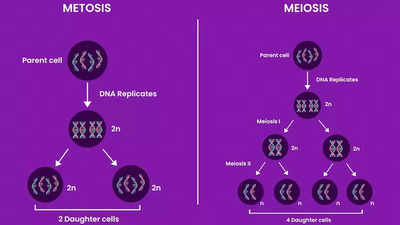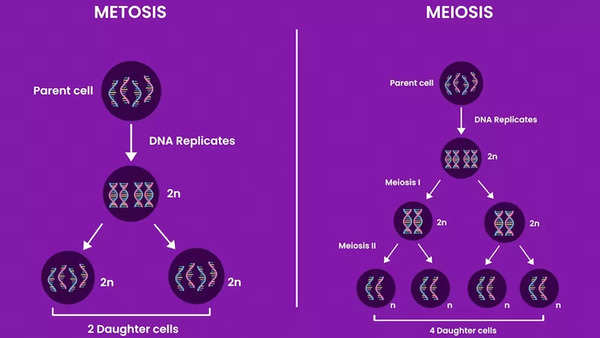- News
- Education News
- Learning with TOI News
- Mitosis and meiosis explained: How cells divide and pass on genetic information
Trending
This story is from May 13, 2023
Mitosis and meiosis explained: How cells divide and pass on genetic information
Embark on an exciting journey to uncover the wonders of cell division as we explore mitosis and meiosis. In this captivating explanation, we'll delve into how cells divide and pass on genetic information, making this complex topic accessible and intriguing for you.

Image source: Freepik
Key Highlights
- Mitosis: Cell division that creates identical copies for growth and repair.
- Meiosis: Cell division for sexual reproduction, generating diverse offspring.
- Mitosis involves four stages: prophase, metaphase, anaphase, and telophase.
- Meiosis has two rounds of division, introducing genetic variation through crossing over and independent assortment.
Welcome to the fascinating realm of cell division, where the magic of life unfolds before our eyes. Cells possess the remarkable ability to multiply, ensuring the growth and development of organisms. Let's embark on a captivating exploration of mitosis and meiosis, the two processes that orchestrate the division of cells and the passage of genetic information.
Mitosis - Creating identical copies for growth and repair
Imagine a city that needs to expand and repair itself.Similarly, in mitosis, cells replicate to create identical copies for the growth and maintenance of our bodies. This process is like making photocopies of an important document to distribute to different departments. Each new cell receives a complete set of genetic information, ensuring that they can perform their specific roles in the body.
Meiosis - Unleashing genetic diversity for reproduction
 (Image source: Freepik)
(Image source: Freepik)
Unraveling the stages: Mitosis and meiosis in action
Zooming in on mitosis, we witness four distinct stages that orchestrate cell division. In prophase, the cell prepares for division, condensing its DNA and getting ready for the next steps. During metaphase, chromosomes align at the center of the cell, just like performers in a grand parade. Anaphase follows, where the chromosomes separate and move towards opposite ends, while telophase concludes the division, forming two identical daughter cells.
In meiosis, the process becomes even more intriguing. During meiosis I, homologous chromosomes pair up and exchange genetic material through crossing over, introducing new combinations. In metaphase I, these pairs align in the center, shuffling the genetic deck. Anaphase I separates the homologous chromosomes, leading to the formation of two cells with half the number of chromosomes. Meiosis II mirrors the stages of mitosis, resulting in the formation of four haploid cells, each with a unique combination of genetic material.
Significance of Mitosis and Meiosis in genetics and reproduction
Both mitosis and meiosis play vital roles in genetics and reproduction. Mitosis ensures the continuity of genetic information, allowing cells to grow and repair in a controlled and precise manner. Meiosis, on the other hand, introduces genetic diversity, contributing to the survival and adaptation of species. Through the processes of crossing over and independent assortment, meiosis generates offspring with new combinations of traits, expanding the possibilities of evolution.
(The content is generated with the assistance of Artificial Intelligence)
Mitosis - Creating identical copies for growth and repair
Imagine a city that needs to expand and repair itself.Similarly, in mitosis, cells replicate to create identical copies for the growth and maintenance of our bodies. This process is like making photocopies of an important document to distribute to different departments. Each new cell receives a complete set of genetic information, ensuring that they can perform their specific roles in the body.
Meiosis - Unleashing genetic diversity for reproduction
Now, let's enter the realm of meiosis, where the creation of unique offspring takes place. Picture a puzzle where pieces come together in different combinations, forming diverse images. Meiosis is responsible for sexual reproduction, generating offspring with variations in their genetic makeup. This process ensures that siblings are not identical but possess distinct traits inherited from both parents.

Unraveling the stages: Mitosis and meiosis in action
Zooming in on mitosis, we witness four distinct stages that orchestrate cell division. In prophase, the cell prepares for division, condensing its DNA and getting ready for the next steps. During metaphase, chromosomes align at the center of the cell, just like performers in a grand parade. Anaphase follows, where the chromosomes separate and move towards opposite ends, while telophase concludes the division, forming two identical daughter cells.
In meiosis, the process becomes even more intriguing. During meiosis I, homologous chromosomes pair up and exchange genetic material through crossing over, introducing new combinations. In metaphase I, these pairs align in the center, shuffling the genetic deck. Anaphase I separates the homologous chromosomes, leading to the formation of two cells with half the number of chromosomes. Meiosis II mirrors the stages of mitosis, resulting in the formation of four haploid cells, each with a unique combination of genetic material.
Significance of Mitosis and Meiosis in genetics and reproduction
Both mitosis and meiosis play vital roles in genetics and reproduction. Mitosis ensures the continuity of genetic information, allowing cells to grow and repair in a controlled and precise manner. Meiosis, on the other hand, introduces genetic diversity, contributing to the survival and adaptation of species. Through the processes of crossing over and independent assortment, meiosis generates offspring with new combinations of traits, expanding the possibilities of evolution.
(The content is generated with the assistance of Artificial Intelligence)
End of Article
FOLLOW US ON SOCIAL MEDIA










